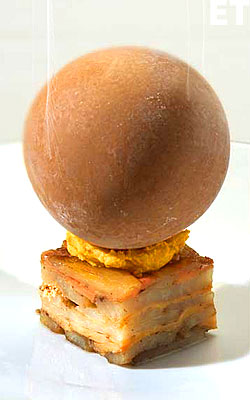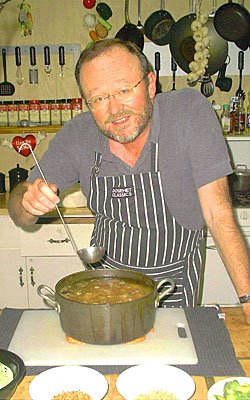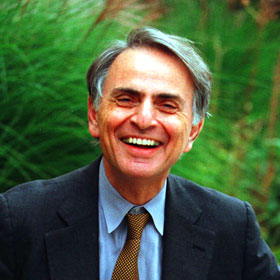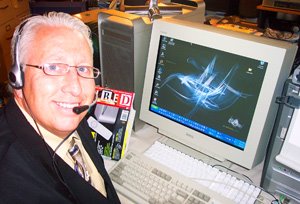Extreme Cuisine!
:: A Chicago Chef is using technology to change the way people think about food!
++ Food Tech: Chicago, USA / Homaro Cantu / Moto | Cuisine
How many times have you been to a restaurant where the menu is edible? How many chefs do you know that use a Class IV laser, tanks of liquid nitrogen, and a vacuum chamber filled with carbon dioxide as important cooking tools? Or use helium, superconductors and a hand-held ion-particle gun to levitate food, making whole meals float before awestruck diners?
 Homaro Cantu, executive chef at Moto in Chicago uses his own combination of childlike humor, high technology, shock value, flavor, and haute cuisine to turn the fine-dining experience on its head! [Image credit: Dan Winters | Fast Company]
Homaro Cantu, executive chef at Moto in Chicago uses his own combination of childlike humor, high technology, shock value, flavor, and haute cuisine to turn the fine-dining experience on its head! [Image credit: Dan Winters | Fast Company]In Cantu's skilled hands, liquid nitrogen becomes a tool for coalescing a pureed head of romaine lettuce into flavorful Pearls of Caesar Salad (chilled to -273 degrees fahrenheit). Carbonation adds fizz to real fruit (an orange bubbles like orange crush soda when squeezed): The result of hours of compression in a carbon dioxide tank at 60 pounds per square inch. Sea bass arrives raw in a heat retaining polymer box heated to 350 degrees, cooking to perfection on the table while two other courses pass by.
Dessert is the most impressive course of all. Cantu fills a sphere with the juice of yuzu (a japanese citrus) and spins it while it is chilled with another dose of liquid nitrogen. What emerges is a thin, spherical shell, almost like an edible balloon. (All that is missing is helium to make the balloon float, and Cantu hopes to add that touch someday soon.)
 Cantu's menu offers the adventurous a bizarre-yet-tasty combination of food and science, of high and low culture, and of the comfortable and the absurd.
Cantu's menu offers the adventurous a bizarre-yet-tasty combination of food and science, of high and low culture, and of the comfortable and the absurd.Case in point is his version of "Surf & Turf": Hawaiian sea bass and duck cooked sous vide (in a vacuum), with mushrooms, a foamy puree of foie gras (duck liver), and apple butter.
Accompanying the dish is synthetic champagne injected into your glass with a giant medical syringe, and a sketch inspired by M.C. Escher (the mind-bending surrealist), depicting a sea that morphs into a sky. The drawing is edible, and if you eat it, you will find the top flavored like a bird and the bottom flavored like a sea!
Another case in point is Cantu's take on the PB&J with milk (photo). The peanut butter is hidden inside a hemisphere of jelly, which rests on a dab of whipped milk. [Image credit: Dan Winters | Fast Company]
Cantu's "sous-chef" is an inkjet printer that he calls the "food replicator" (in homage to Star Trek). He prints images of fish on pieces of edible paper made of soybeans and cornstarch, using organic, food-based inks of his own concoction. He then flavors the back of this special paper (which is ordinarily used to put images onto birthday cakes) with powdered soy and seaweed seasonings, rolls the paper up and stuffs it with fish and rice, in order to create his own version of "sushi".
He also prepares edible photographs flavored to fit a theme: An image of a cow, for example, might taste like filet mignon. On the set of Iron Chefs of America, he took a digital photo of himself and his two sous chefs drinking a cocktail flavored with horchata (a Mexican rice-based beverage). He then poured his cocktail into his "food replicator" and it printed out a horchata-flavored picture, which he served to the judges along with a dessert of Mexican chocolate pudding with beets and caramelized popcorn.
 On a Cantu-designed plate (photo), diners use pipettes to add flavors to their desserts. The choices are: Chile-mascarpone, milk-chocolate-sesame, and orange-olive-oil. [Image credit: Dan Winters | Fast Company]
On a Cantu-designed plate (photo), diners use pipettes to add flavors to their desserts. The choices are: Chile-mascarpone, milk-chocolate-sesame, and orange-olive-oil. [Image credit: Dan Winters | Fast Company] Make no mistake that Cantu has not lost sight of what brings us all to the dinner table – great tasting food. While guests may be positively shell shocked with some of the mind boggling creative creations of Cantu, rest assured that this young chef can cook. Having grown-up in Portland, Oregon, Cantu graduated from Le Cordon Bleu. He then worked his way up the ranks in nearly 50 kitchens on the West Coast before moving to Chicago to work at Charlie Trotter’s. Cantu spent four years there attaining the coveted title of Sous Chef before leaving to open "Moto | Cuisine".
Make no mistake that Cantu has not lost sight of what brings us all to the dinner table – great tasting food. While guests may be positively shell shocked with some of the mind boggling creative creations of Cantu, rest assured that this young chef can cook. Having grown-up in Portland, Oregon, Cantu graduated from Le Cordon Bleu. He then worked his way up the ranks in nearly 50 kitchens on the West Coast before moving to Chicago to work at Charlie Trotter’s. Cantu spent four years there attaining the coveted title of Sous Chef before leaving to open "Moto | Cuisine".Since opening "Moto | Cuisine", Chef Homaro Cantu has attracted much attention with his interpretation of Postmodern Cuisine. While Postmodern Cuisine is in its infancy in America, it seems that many diners and critics weighing-in on this new style of cuisine still view it as the "Wild West of whimsy". And this is true at "Moto | Cuisine", because the sky is the limit as Cantu stretches known scientific and gastronomic boundaries.
 Postmodern Cuisine, often times referred to as Avant-Garde cuisine, found its roots in Spain with Ferrán Adrià of El Bulli leading the evolution. With the exact definition of Postmodern Cuisine still open for interpretation, it is safe to describe this culinary movement as one that reacts against earlier modernist principles. It reintroduces traditional or classical elements, typically carrying modernist styles or practices to extremes. [Image Credit: Moto | Cuisine]
Postmodern Cuisine, often times referred to as Avant-Garde cuisine, found its roots in Spain with Ferrán Adrià of El Bulli leading the evolution. With the exact definition of Postmodern Cuisine still open for interpretation, it is safe to describe this culinary movement as one that reacts against earlier modernist principles. It reintroduces traditional or classical elements, typically carrying modernist styles or practices to extremes. [Image Credit: Moto | Cuisine]Chef Cantu simply describes it as, “The human race has been eating the same way for hundreds and hundreds of years. At Moto, we strip away the rules, stretch the imagination and entice guests with never-before seen dishes. It’s about being open-minded and having a lot of fun with food.”For Cantu, edible paper is just one of his many creative ideas. Another idea will be to use nanotechnology to create time-release foods that expand to fill your stomach.
Already, Cantu is part of a group working with the Institute of Advanced Concepts, the futurist arm of NASA, to help rethink notions of food in space.
Cantu is obsessed with patenting his ideas in a world in which the battle for intellectual property can make or break a business. With the help of his patent attorney, Charles Valauskas, a partner at Baniak Pine & Gannon, he has 12 patents pending, including the polymer cooking box, a utensil that can deliver an entire dish (from within its handle) with the push of a button, a prototype for a combination fork-spoon-knife, and his edible paper (with many others ideas on there way).

"Moto’s cuisine is such a unique combination of culinary expertise, artistic ability, chemistry, and technological innovation. The food is delicious, visually appealing, and every course challenges your senses and gives you something new to think about and experience." ~Linda | At Our Table [Image Credit: Linda | At Our Table]If you are not fortunate enough to live near Chicago (I live in California), you can still visit Moto, by taking a "virtual" tour via a blog titled "At Our Table", from a fellow food fan, Linda (who lives there). Linda visited Moto for a birthday celebration, and she has the photos to prove it! She chose to experience this unique restaurant through their Grand Tour Moto ("GTM" - $240 per person) menu choice, featuring 18 (with gusts up to 20) courses and an accompanying 13-step wine progression (with champagne - if it's your birthday). You can enjoy Moto vicariously by reading her article, titled "Have you had Doughnut Soup?: 18 Unique Courses at Moto".
Note From Technophile: Behind the scenes, Cantu continues to experiment: A medical centrifuge, designed to separate blood proteins, could clarify rich, thick meat stocks. A high powered laser could cook beef with a precision impossible on a grill. It could also be used to burn a hole through a piece of sashimi tuna, cooking the fish thoroughly inside but leaving its exterior raw. And it could be used to create "inside out" bread (where the crust is baked inside the loaf and the doughy part is the outer surface). Cantu meets with DeepLabs, conveniently located around the corner from the restaurant, on a weekly basis to strategize on what he calls his “Star War’s stuff” to make his dreams a reality. Cantu also sees a humanitarian end to his culinary trickery. He envisions dispensing vitamin-enriched edible books in regions where people suffer from malnutrition; each page would be both food and information about when and how best to eat it.:: Source: [Fast Company Magazine, May, 2006]
:: Image Credits: [Dan Winters | Fast Company / Linda | At Our Table / Moto | Cuisine]
:: Innovation: Using humor, technology, shock value, and flavor to redefine the nature of food!
:: Available: Now (at Moto, in Chicago).
:: Cost: $240 per person for a 20 course tasting menu with wine.
"The only difference between a madman and me is that I am not mad." ~Salvador Dali (from the huge photo of Salvador Dali mounted above the stairs leading into the basement kitchen of Moto Restaurant, Chicago, Illinois, USA)
 Note from Technophile: My name is Don Cook, I am the author of this blog, and one of my hobbies (for the last 25 years) has been gourmet cooking. I have won several cooking contests including a clam cook-off and a chili cook-off in Mexico, and have taken classes at 4 different cooking schools.
Note from Technophile: My name is Don Cook, I am the author of this blog, and one of my hobbies (for the last 25 years) has been gourmet cooking. I have won several cooking contests including a clam cook-off and a chili cook-off in Mexico, and have taken classes at 4 different cooking schools.If you do not live near Chicago, or if you don't feel like going out to eat, you can still enjoy a fabulous meal in the privacy of your home. One of our sponsors, Legal Sea Foods is proud to report to us that they are still at the #1 spot in Boston’s Zagat Survey for 2005/06. This award illustrates their dedication to serving and delivering the absolute freshest fish in the seafood industry (which they have for over 50 years). Legal Sea Foods has set the standard for quality and freshness with seafood and gourmet products that you will love. Their popular food items include live lobsters, salmon, filet mignon, jumbo shrimp, clam chowder, gourmet chili, oysters, desserts (like Boston cream pie), sauces (like chipotle marinade), and spices, just to name a few. You owe it to yourself to check out their extreme site and their extreme cuisine!




















0 Comments:
Post a Comment
<< Home